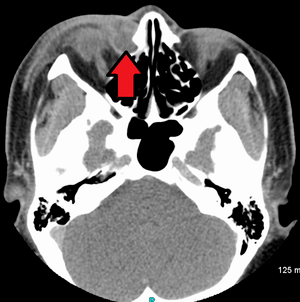Dacryocystitis
| Dacryocystitis | |
|---|---|
 | |
| A case of dacryocystitis as seem on CT scan | |
| Classification and external resources | |
| Specialty | Ophthalmology |
| ICD-10 | H04.3-H04.4 |
| ICD-9-CM | 375.30 |
| DiseasesDB | 3432 |
| eMedicine | article/1210688 |
| MeSH | D003607 |
Dacryocystitis is an infection of the lacrimal sac, secondary to obstruction of the nasolacrimal duct at the junction of lacrimal sac. The term derives from the Greek dákryon (tear),[1] cysta (sac), and -itis (inflammation). It causes pain, redness, and swelling over the inner aspect of the lower eyelid and epiphora. When nasolacrimal duct obstruction is secondary to a congenital barrier it is referred to as dacrocystocele. It is most commonly caused by Staphylococcus aureus and Streptococcus pneumoniae.[2] The most common complication is corneal ulceration, frequently in association with S. pneumoniae.[2] The mainstays of treatment are oral antibiotics, warm compresses, and relief of nasolacrimal duct obstruction by dacryocystorhinostomy.[2]
Signs and symptoms
- Pain, swelling, redness over the lacrimal sac at medial canthus
- Tearing, crusting, fever
- Digital pressure over the lacrimal sac may extrude pus through the punctum
- In chronic cases, tearing may be the only symptom
Pathophysiology
A variety of causes may lead to dacrocystitis. Most notably, obstruction of the nasolacrimal duct leads to stasis of the nasolacrimal fluid, which predisposes to infection. Staphylococcus aureus is a common bacterial pathogen causing infectious dacrocystitis.[3] Sometimes, especially in women, stones may develop in the lacrimal gland, causing recurrent bouts of dacrocystitis; this condition is called "acute dacryocystic retention syndrome."[3] Also due to pneumococcus, infection due to surrounding structure such as paranasal sinuses.
Prognosis and complications
About 60 percent of initial attacks of dacryocystitis will recur.[3] Individuals with a poorly functioning immune system (immunocompromised) may develop orbital cellulitis, which may lead to optic neuritis, proptosis, motility abnormalities, or blindness.[3]
See also
References
- ↑ "Dacryo- definition". Retrieved 2009-05-18.
- 1 2 3 Oill PA; Montgomerie JZ; Cryan WS; Edwards JE (March 1977). "Specialty conference. Infectious disease emergencies. Part V: patients presenting with localized infections". The Western Journal of Medicine. 126 (3): 196–208. PMC 1237503
 . PMID 349885.
. PMID 349885. - 1 2 3 4 Yanoff, Myron; Duker, Jay S. (2008). Ophthalmology (3rd ed.). Edinburgh: Mosby. pp. 1482–1485. ISBN 978-0323057516.